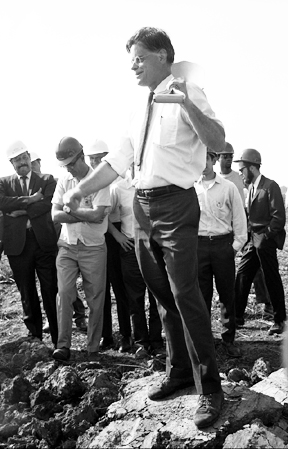Robert R. Wilson
|
|
Robert Rathbun Wilson (March 4, 1914–January 16, 2000) was an American physicist who was the youngest group leader of the Manhattan Project, a sculptor, and an architect of Fermi National Laboratory (Fermilab), where he was also the director from 1967-1978.
Wilson was born in Frontier, Wyoming in 1914. In 1932 he arrived at Ernest O. Lawrence's Radiation Laboratory at the University of California, Berkeley, which was at that time blossoming into the top American site for both experimental and theoretical physics due to the efforts of Lawrence and J. Robert Oppenheimer.
But Wilson ran into friction with Lawrence's harsh frugality while working on his cyclotron and was fired twice from the Rad Lab. The first time, for losing a rubber seal in the 37-inch cyclotron which prevented its use in a demonstration to a potential donor; he was later rehired at Luis Alvarez's urging. However he soon melted a pair of pliers during a welding job, and was again fired. Though offered his job back, he decided instead to go to Princeton to work with Henry DeWolf Smyth.
At Princeton, Wilson eventually took over Smyth's project: an alternative approach to electromagnetic separation from Lawrence's Calutrons, for the purpose of separating the valuable light isotope of uranium from the immensely more common heavy one (a key step to producing an atomic bomb). By 1941 the project had produced a device called the "Isotron," which different from the Calutron as it used an electrical field to separate the uranium, not a magnetic one.
When Robert Oppenheimer's secret centralized laboratory for war research on the atomic bomb—Los Alamos—opened in 1943, Wilson was appointed as head of the Cyclotron Group (R-1) by Oppenheimer. Only in his late twenties, he was the youngest group leader in the experimental division.
In 1945, when Nazi Germany surrendered, and the initial motivation for the crash atomic bomb project (the Manhattan Project) dissipated as it was discovered that the Nazi atomic research program was years behind, Wilson attempted to raise the question at the lab of whether they should continue with their work. News of this was met with an icy reception from General Leslie Groves, military head of the project.
After the bombings of Hiroshima and Nagasaki, Wilson helped create the Association of Los Alamos Scientist (ALAS), which called for, with a scientists' petition, the international control of atomic energy. The petition was carried by Oppenheimer to Washington, D.C., eventually made its way to Secretary of War Henry L. Stimson and eventually President Harry S. Truman. Ironically the Russians may have seen it first—atomic spy Klaus Fuchs gave Harry Gold a copy which arrived in Moscow on October 29, 1945, and was noted upon that the physicists' "feelings of distrust toward the government are very strong."
Wilson helped form the Federation of American Scientists after the war and served as its chairman in 1946. He accepted an offer to go to Harvard for a brief period (most of which was spent at Berkeley), and went to Cornell University in 1947 where he worked at the Cornell Laboratory of Nuclear Studies. His work there eventually led to the construction of a particle accelerator, the Cornell Electron-positron Storage Ring (CESR), now located at the Wilson Synchrotron Laboratory.
In 1967 he took a leave of absence from Cornell to assume directorship of the not-yet-created National Accelerator Laboratory which was to create the largest particle accelerator of its day at Batavia, Illinois. In 1969, Wilson was called to justify the multimillion-dollar machine to the Congressional Joint Committee on Atomic Energy. Bucking the trend of the day, Wilson emphasized it had nothing at all to do with national security, rather:
- It has only to do with the respect with which we regard one another, the dignity of men, our love of culture. It has to do with: Are we good painters, good sculptors, great poets? I mean all the things we really venerate in our country and are patriotic about. It has nothing to do directly with defending our country except to make it worth defending.
Thanks to Wilson's leadership—in a full-steam ahead style very much adopted from Lawrence, despite his firings—the facility was completed on time and under budget. Dubbed the Fermi Accelerator Laboratory (Fermilab for short), after famed Italian physicist Enrico Fermi, the facility centered around a four-mile circumference, 400 GeV accelerator. Unlike most government facilities, Fermilab was designed to be aesthetically pleasing. Wilson wanted Fermilab to be an appealing place to work, believing that external harmony would encourage internal harmony as well, and labored personally to keep it from looking like a stereotypical "government lab", playing a key role in its design and architecture. It had a restored prairie which served as a home to a herd of American Bisons, ponds, and a main building purposely reminiscent of a cathedral in Beauvais, France. Wilson served as the director of Fermilab until 1978 and afterward retired to Ithaca.
Wilson received many awards and honors, including the National Medal of Science in 1973, the Enrico Fermi Award in 1984, and was elected to the National Academy of Sciences, the American Academy of Sciences, and the American Philosophical Society. He was president of the American Physical Society in 1985. A metal sculpture created by Wilson sits in the lobby of the Harvard Cabot Science Center building.
He died at the age of 85 at his home in Ithaca, New York after a prolonged illness in January 2000.
References
- Gregg Herken, Brotherhood of the Bomb: The Tangled Lives and Loyalties of Robert Oppenheimer, Ernest Lawrence, and Edward Teller (Henry Holt and Co., 2002).
External links
- The birth of Fermilab according to Wilson (http://www.fnal.gov/projects/history/wilson/cover.html)
- Obituary (http://www.thebulletin.org/issues/2000/ma00/ma00wilson.html) by the Bulletin of the Atomic Scientists
- Wilson's account of his work at Los Alamos (http://www.lanl.gov/orgs/p/hist_wilson.shtml)de:Robert R. Wilson

